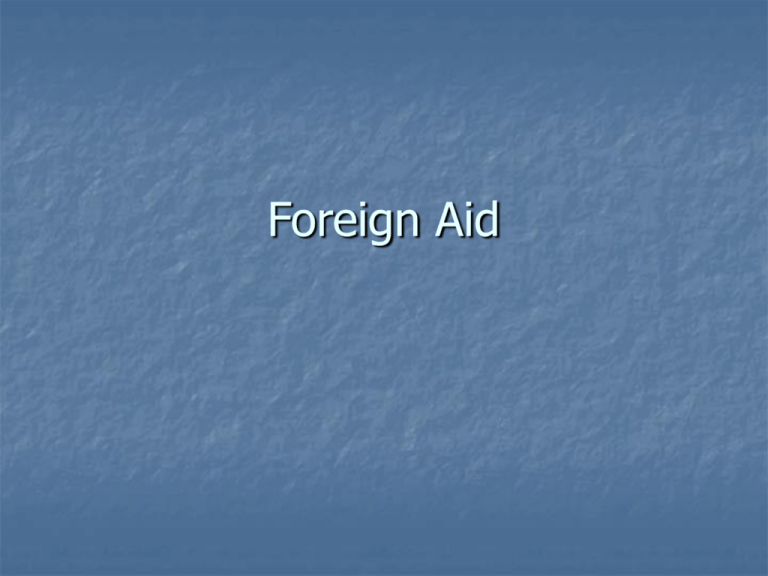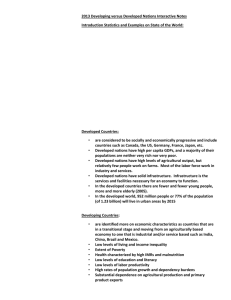Foreign Aid
advertisement

Foreign Aid Objectives: To further understanding of Foreign Aid To examine the idea of Free Trade/Fair Trade Agenda: Lecture Review/Discuss Charts in Groups Answer these questions: 1. What % of the U.S. economy is spent 2 on Foreign Aid? I. Development Assistance Photo A. What is Foreign Aid Def: Private & public resource transfers ($) from DCs to LDCs B. Why Do DCs & Organizations Give Foreign Aid? o Promote economic development (e.g., education, health) o Support their security, military, political & strategic interests o Dispose of “surplus” grain/sell other products o Encourage human rights, economics policy& democratic reforms o Respond to humanitarian disasters (tsunamis, famines, earthquakes) o Other? 3 C. Who Provides Foreign Aid & Why? 1. Public sources: "Official Development Assistance" (ODA) Note: ODA only includes $ that goes to poor LDCs for development & humanitarian assistance o Major multilateral donors ($ from DCs to LDCs via an international organization) UN Agencies--FAO, WFP, UNDP, IFAD, WHO, UNICEF Non-UN Agencies--WB & IMF (big!), Euro.Development Fund Regional Dev.Banks--Asian, African, Inter-Amer.Dev. Bank Why? to promote development & economic reforms o Major bilateral donors ($ from a DC to a govts. & NGOs in LDCs) Western DCs (especially to former colonies) OPEC countries (especially to Arab world) Japan (especially to Asia) Why? Promote security, economic/political reforms, dispose of 4 agricultural surpluses (i.e., US) 2. Private sources ($ from orgs. & individuals to international organizations, & NGOs working in LDCs) o Foundations: Rockefeller, Ford, Kellogg, Gates o Churches: World Council of Churches, individual denominations o NGOs: Oxfam, CARE, CRS, Save the Children, Doctors Without Borders, World Vision, etc. o Private philanthropy—some recent examples Gates–donates more $ for world health (AIDS, TB, malaria) that U.S. govt.! Buffett—$30.7 billion via Gates Foundation Turner–in late 1990s, gave $34 billion to pay US’s UN debt, $1 billion to UN humanitarian programs. Soros–gives $ to private institution in 27 former communist countries to strengthen civic society Why? Promote humanitarian concerns, development 5 Final 5 What should be done about financial aid going to foreign countries? Should the amount of money be determined by each government based on need or based on willingness to help? 6 3. US Resource Flows to Developing World ($70.5 billion, 2000) (Fig.) A broader concept of foreign aid (USAID new idea!) o Foreign direct investment (FDI):.……………………… 39% o Personal remittances (esp, to Mexico, Brazil): ..……. 25% o ODA (Part I, poor LDCs, & Part II, other countries):… 18% o Religious organizations:………………………………… 5% o NGOs/PVOs: ……………………………………………. 5% o Corporations/corporate foundations: …………………. 4% o University/college scholarships:…………………….….. 2% o Foundations: ………………………………………….…... 2% Should these all be called “foreign aid”? 4. Worldwide Resource Flows (2003) FDI=$301 billion, Remittances=$126 billion, Bilateral Aid=$68 billion, World Bank=$20 billion, NGOs=$5 billion D. Is Foreign Aid (ODA) a gift? o Loans--made at commercial or subsidized interest rates WB & Int. Monetary Fund primarily make loans which must be repaid o Grants--no repayment required, bilateral aid is mostly grants 7 II. UN Millennium Development Goals They are a blueprint--agreed to by all countries & leading development institutions—for meeting the needs of the world’s poorest What are the 8 key goals? (2015) o Eradicate extreme poverty & hunger o Achieve universal primaryeducation o Promote gender equality & empower women o Reduce child mortality o Improve maternal health o Combat HIV/AIDS, malaria & other diseases o Ensure environmental sustainability 8 o Develop a global partnership for development III. US Foreign Aid Spending ($20.7 billion, 2004) Table, pie) (Foreign Operations Budget) A. Military Assistance ($3.4 billion, 23%) o Mostly to Israel, Middle East countries) B. Economic/Political Security Assistance ($5.4 billion, 26%) o Supports for US security interests, $ is paid directly to the govt. o Goal--assist "friendly" governments facing a crisis/threat o Provides $ for country to import goods, pay foreign debts Examples--Aid to Vietnam (formerly), Israel, Egypt, Afghanistan C. Bilateral Development Aid ($6.2 billion, 30%) Types of Activities Supported o Projects designed to strengthen/build agricultural research, family planning, road, health services, universities, environment Typical Project Components o Technical assistance--pays salaries for "experts" to teach, plan & manage projects o Training--scholarships to study in US (Fulbright program) 9 o Commodities—buildings, vehicles, equipment Example--USAID/MSU/Univ. of Zimbabwe Faculty Expansion Project o US faculty go UZ to teach, supervise research o Zimbabwe faculty to U.S. for MS/PhD study o Purchased equipment for UZ (computers, labs) D. Humanitarian/Disaster Relief Assistance ($2.6 billion, 12%) o Assistance to people affected by tsunamis, earthquakes, drought o Food Aid--LDC typically pays for food with local currency E. Multilateral Development ($1.7 billion, 8%) US government transfers $ to international agencies (FAO, WHO, UNDP, UNAIDS, regional banks, etc.) A. Foreign Aid-Related Expenditures NOT Considered ODA) o Military Aid--addresses US security concerns o Drug suppression--reduces flow of drug to the US o Debt forgiveness--reduces LDC’s debt burden o Subsidies to US exporters--provides subsidies & repayment guarantees to promote US exports o State Department—supports diplomatic relationships abroad o Peace Corps—supports humanitarian projects 10 IV. History of U.S. Foreign Aid Program Overview o US has given aid given throughout its history Note: Ben Franklin, earliest example, offered to send sons to college after Iroquois signed a treaty with the US government o Formalized & expanded since WW II o Has primarily focused on promoting the “national interest” (i.e., US foreign policy objectives) A. Early AID Programs 1. Lend-Lease (1941-45): provided military support to European allies 2. Marshall Plan (1948-52): provided funds to rehabilitate Europe 3. Mutual Security Act (1951): provided military aid to support security interests in Europe/Asia (Korean war, cold war) 11 B. Foundations For Current AID Program 1. Roosevelt—sought to build a more liberal political & economic order o Build international orgs./UN to insure world peace & stability 2. Truman—emphasized technical assistance o Give LDCs access to science & technology 3. Kennedy (1960)—“prosperous world is a more secure world” o Increase economic growth (not development) via industrialization o Assumed benefits would "trickle down" to the poor 4. Johnson (1963)—aid to SE Asia, driven by the Vietnam War 5. Nixon (1968)--help the “poorest of the poor” o Focused on supporting agricultural, nutrition, population, health, education projects (build land grant universities in LDCs) that were very expensive 12 6. Reagan (1980)--need to focus resources on more cost-effective and strategic projects o Promoted policy reforms, beginning of Washington Consensus 7. Bush I (1988)--LDC’s policies discourage development, so o Link aid to economic policy, human rights & democratic reforms o Strengthen the private sector & work with NGOs o Promote sustainable development (more $ for population, environment) 8. Clinton (1992): “sustainable development” o Focused on economic growth & agricultural development; population, health & nutrition; environment; democracy & governance; education & training; humanitarian assistance 13 C. USAID’s (Bush II) Bilateral Program ($8.2 billion, 2004) (Excluding $18 billion for Iraq) 1. Three Pillars (http://www.usaid.gov) (Table) o Economic Growth, Agriculture &Trade (54%) Focus: a) interdependence of economic growth & agricultural development, b) sustainability, c) human capital to create viable market economies o Democracy, Conflict, &Humanitarian Assistance (15%) Focus: a) promote peaceful resolution of conflict, b) citizen participation & growth of democracies, c) respond to manmade/natural disasters–including food aid o Global Health (31%) Focus: a) maternal & child health, nutrition, women’s reproductive health, b) HIV/AIDS, c) infectious diseases Now—Current Categories: Agriculture, Democracy & Governance, Economic Growth & Trade, Environment, Education & Training, 14 Global Health, Global Partnerships 2. Regional Distribution—excl. Iraq ($8.2 billion, 2004) (Figure) o Middle East Israel=US$ 2.6 billion Egypt=US$ 1.37 million o Africa o South Asia o Europe (inc. Russia & NIS) o Latin America & Caribbean o East Asia (38.4%) (18.3%) (17.3%) (11.4%) (11.4%) (3.1%) 3. Recent Trends in U.S. ODA o Increase in bilateral aid (2001=$5.9 billion, 2004=8.2 billion) o More aid for new initiatives Global AIDS Initiative Millennium Challenge Account o More aid to Africa (health), global war on terrorism partners (Figure) o More aid to Afghanistan & Iraq o Less aid to Europe 15 V. Is Foreign Aid a Success or a Failure? A. Many accomplishments: o Major improvements in LDCs--infant mortality; life expectancy, literacy, health services, school enrollment o Many successful projects: Examples Infrastructure--roads, dams, universities Health--smallpox, oral rehydration, AIDS, family planning Agriculture--research, famine early warning, new crop varieties But hard to measure foreign aids’ impact on “economic development” o AID has multiple objectives (security more than development!) o Problems facing LDCs are great, $ for foreign aid is very small Note: Total ODA DCs gave to LDCs (2002) was about $10/capita ($56 billion), but increased to about $104 billion in 2007 (Map) o Many years are require to see the impact of a project o Hard to sort out "other" factors (e.g., weather, conflicts) 16 B. What are Some Major Criticisms of Foreign Aid? o We can’t afford to aid to LDCs--should 1st address unmet US needs But AID is only a small part (0.9%) of the US Federal budget (Figure) o AID goes to corrupt leaders in LDCs But Aid has been and still is given for political/security reasons Reforms have been made to increase accountability/reduce corruption (e.g., Millennium Challenge Account, new WB policies to combat corruption) o AID benefits rich people in LDCs, not the poor But Aid is now being redirected to: Preserve the environment, promote health &nutrition Support free market economic reforms, promote democracy 17 o AID doesn’t help the US But Most aid $ are actually spent in the US (80%) US benefits, if foreign aid helps LDCs to develop: Creates new export markets for US firms Exports created jobs for Americans Reduces illegal immigration from poor LDCs Reduces environmental spillover Reduces threat/spread of human/crop diseases US benefits if foreign aid prevent “failed” states (e.g. states that harbor terrorists, drug traffickers, spark humanitarian disasters, undermine the global economy) C. What Lessons Have we Learned for Making Foreign Aid More Effective in Promoting Development? o Aid’s impact is greatest, if LDC’s policies support free market, exports, private enterprise, democracy o Investments in human capital (people), institutions & infrastructure 18 are the key catalysis of economic development VI. Future of Foreign Aid A. United States 1. Most Americans support Foreign Aid o 2000 Poll—Most supported giving aid, but thought US spent too much (20% of federal budget)--10% was preferred! (Actual =0.9%) o 2006 Poll—65% felt US should give 0.7 of GDP to assist poor countries, 71% were willing to give $15-$30/capita to achieve Millennium Development goals 2. Post 9/11 has increased Congress’s support for foreign aid (Cartoon) o Millennium Challenge Account (a new Bush initiative) Commits US to increase aid by US$5 billion over current level (2006) Aid will target LDCs that show strong commitment to good governance/fighting corruption, improving health/education & pursuing economic policies that foster enterprise o HIV/AIDS--$15 billion over next 5 years o But aid will still be driven by national security issues (terrorism, oil) Winners: Iraq, Afghanistan, oil exporters Losers: human rights, non-frontline nations 19 Final 5: Where should the money going to aid be distributed? AS it is? Or a new balance of distribution? What order would you suggest? 20







